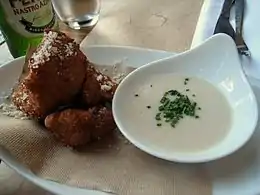Agliata
Agliata (Italian pronunciation: [aʎˈʎaːta]; from aglio, "garlic"; Ligurian: aggiadda [aˈdʒadˑa]) is a savory and pungent garlic sauce and condiment in Italian cuisine used to flavor and accompany grilled or boiled meats, fish and vegetables.[1][2][3] It is first attested in Ancient Rome, and it remains part of the cuisine of Liguria. Porrata[4] is a similar sauce prepared with leeks in place of garlic.

Preparation
Agliata is prepared with crushed garlic, olive oil, bread crumbs, vinegar, salt and pepper. The bread crumbs are soaked in vinegar, which is then squeezed out, after which the garlic is whisked or beaten into the mixture. Its preparation includes the emulsion of the ingredients to prevent separation, which is performed by the olive oil being added in a slow drizzle while the mixture is constantly whisked. It generally accompanies grilled or boiled meat, fish and vegetables.[1][2][3]
History
The origins of agliata date to Ancient Rome.[1] It has been described as a social-class crossover — typical peasant food also used by upper-class people.[2] The Venetian, a 14th-century cookbook, stated that agliata can be served "with all kinds of meat",[2] as reported by the Liber de Coquina, first published in the 13th century, where it is stated it can be used to "accompany any kind of meat".[2]
Agliata is used in the cuisine of Liguria to accompany meats and fish, and has been described as "a Ligurian classic".[3][5] It is still commonly used in Italian cooking.[1]
Similar foods
Porrata sauce is prepared using all of the ingredients in agliata except for the garlic, which is substituted with leeks (porri in Italian).[1]
See also
- Aioli – Mediterranean sauce made of garlic and olive oil, optionally egg yolks and seasonings
- Honey garlic sauce
- List of condiments – Wikipedia list article
- List of Italian dishes – Wikipedia list article
- List of sauces – Wikipedia list article
- Mujdei – A spicy Romanian sauce made mostly from garlic and vegetable oil – a Romanian garlic sauce
- Skordalia – A thick purée in Greek cuisine using crushed garlic with a bulky base and olive oil – a Greek garlic sauce
- Toum – A garlic sauce common in the Levant – A Middle-Eastern garlic sauce
References
- May, T. (2005). Italian Cuisine: The New Essential Reference to the Riches of the Italian Table. St. Martin's Press. p. 25. ISBN 978-0-312-30280-1. Retrieved March 4, 2016.
- Capatti, A.; Montanari, M.; O'Healy, A. (2003). Italian Cuisine: A Cultural History. Arts and Traditions of the Table: Perspe (in Italian). Columbia University Press. p. 36. ISBN 978-0-231-50904-6.
- Crocetti, Adri Barr (April 18, 2015). "A Heritage Pasta". L'Italo-Americano. Retrieved March 4, 2016.
- "PORRATA: Vocabolario della Crusca, Firenze – 4ª edizione (1729–1738)".
- Bastianich, L.M.; Manuali, T.B. (2015). Lidia's Mastering the Art of Italian Cuisine. Knopf Doubleday Publishing Group. p. pt1038. ISBN 978-0-385-34947-5.
External links
| Wikimedia Commons has media related to Agliata. |
- "Recipe: Chicken Thighs With Snap Peas and Agliata". Oakland Tribune. October 7, 2008. Archived from the original on 2016-05-05. Retrieved 2016-03-04.